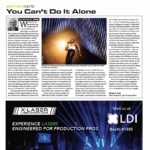We rely on our hearing more than you think. Hearing calls come over the headset. Hearing is also important for communicating effectively with others on deck and, most importantly, the call-outs and warning signals of dangerous situations.
Over the past 10 years, I always thought that my hearing had diminished some. I can certainly still hear, but there are times when I miss something or ask for something to be repeated.
While planning my meetings for InfoComm, I learned the House Research Institute, (www.hei.org) was offering free hearing exams on the show floor. I thought, “What the hell, why not!” It was time to finally see if my assumptions were correct. Well, as it turns out, for my age, I have lost 15 percent more than what might be normally expected for an average male in my age bracket.
Not life-shattering, but still disappointing. I have neglected something I use constantly. There are many reasons why I could have lost my hearing, but the main reason is being careless early on in my career. Working numerous concerts front of house and sometimes directly in front of the speakers without hearing protection is the leading contribution. Another is listening to music with headphones and cranking them to full. Not very smart moves, thinking back on it now. Being young and stupid… I’m paying for it now, but it’s time to protect what is left of my hearing.
Until we can figure out how to grow new eardrums, once you lose your hearing, it is gone. There is no way to bring it back. Hearing aids might be an option, but a costly one. My mother is currently researching hearing aids. For the amount of hearing she has lost, her doctor is recommending hearing aids that cost $3K…each. And hearing aids don’t even restore your hearing — they are designed mostly to amplify midrange sounds so you can hear speech clearly … they’re anything but Hi-Fi!
Ways to Protect Yourself
George Peterson, the editor of our sister magazine, FRONT of HOUSE, says there are a number of ways to protect your fragile eardrums. The first: stay away from loud noises! If that’s not an option, monitor the noise levels. Almost all smart phones these days can download apps. Like Apple’s catch phrase, “there’s an app for that,” there are a number of decibel meters apps available. They may not be the most accurate, but they can certainly alert you if you are getting dangerously close to 115dB, the point where sound begins to hurt.
Another line of protection — certainly the most cost-effective — is disposable foam ear plugs. Since we work in loud environments, most production/tour managers offer these for free to the road crew. If they don’t, pick some up at a home improvement center. Be warned though, the NRR (Noise Reduction Rating) on these types of ear plus is only 29dB. And some say that number is inaccurate — they might only protect half of that. Even 3M, the manufacturer of disposable foam hearing protect, notes that the stats might be inflated. Still, some protection is better than none.
Another and popular method found in almost all road crews’ ears these days is custom-molded hearing protection with noise-canceling protection. This type of protection is a bit more costly — around $200 — but offers an NRR of at least 30dB or better.
Ultimately, you’ll have to weigh the options and pick the solution that works best for you.
I encourage you to get your hearing checked now and continue to monitor it over the course of your career. There are a number of resources available. One of them is online, at plsn.me/onlinehearingcheck. While fun and interesting, it is not the most scientific or definitive test. Many places that sell hearing aids also offer free hearing exams. Be warned, though — they have ulterior motives, like selling you hearing aids. The best option is talking with your doctor about seeing an audiologist and getting a proper test done. A yearly checkup and hearing test might be available for the price of a co-pay.
Wearing earplugs may feel unnatural at first. They may even look uncool, or turn heads while walking front of house. But hearing protection is essential. You’ll thank me after the show when your ears aren’t ringing. Will you spend $100-$200 dollars now to protect your hearing? Or will you hold off and spend the rest of your life saying “Huh? Can you repeat that, please?”
Give Justin a shout-out at jlang@plsn.com.


